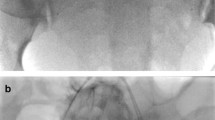Abstract
Objective
To describe the use of intrauterine inflated Foley’s catheter balloon for control of postpartum hemorrhage (PPH) during cesarean section (CS) in cases of abnormally invasive placenta previa aiming to preserve the uterus.
Methods
Retrospective case–control study of the data of women who underwent elective CS on abnormally adherent placenta previa was carried out. Women in whom inflated Foley’s catheter balloon was used for control of PPH during CS (n = 40) were compared with a control group of women who underwent elective CS by the same technique but without use of intrauterine catheter balloon (n = 38).
Results
Use of intrauterine inflated Foley’s catheter balloon significantly reduced the estimated amount of blood loss (P = 0.008), amounts of crystalloids, colloids and packed red blood cells transfusion (P = 0.025, 0.017 and 0.022, respectively), and the need for bilateral internal iliac artery (IIA) ligation (P = 0.016). No significant difference was observed between both groups regarding the use of massive transfusion protocol, performing cesarean hysterectomy, relaparotomy, and admission to the intensive care unit.
Conclusion
Application of an intrauterine inflated Foley’s catheter balloon during CS in cases of morbidly adherent placenta previa helps to control PPH with preservation of the uterus and decreases the need for the invasive IIA ligation.
Similar content being viewed by others
References
Silver RM. Abnormal placentation: placenta previa, vasa previa, and placenta accreta. Obstet Gynecol. 2015;126(3):654–68.
Bauer ST, Bonanno C. Abnormal placentation. Semin Perinatol. 2009;33(2):88–96.
Fitzpatrick KE, Sellers S, Spark P, et al. The management and outcomes of placenta accreta, increta, and percreta in the UK: a population-based descriptive study. BJOG. 2014;121(1):62–71.
Royal College of Obstetricians and Gynaecologists (RCOG). Placenta praevia, placenta praevia accreta and vasa praevia: diagnosis and management (Green-top Guideline No. 27). London: RCOG, 2011. p.26.
Eller AG, Porter TF, Soisson P, et al. Optimal management strategies for placenta accreta. BJOG. 2009;116(5):648–54.
Shabana A, Fawzy M, Refaie W. Conservative management of placenta percreta: a stepwise approach. Arch Gynecol Obstet. 2015;291(5):993–8.
Nagai S, Kobayashi H, Nagata T, et al. Clinical usefulness of Bakri balloon tamponade in the treatment of massive postpartum uterine hemorrhage. Kurume Med J. 2016;62(1–2):17–21.
Schorn MN. Measurement of blood loss: review of the literature. J Midwifery Womens Health. 2010;55(1):20–7.
Raymer JM, Flynn LM, Martin RF. Massive transfusion of blood in the surgical patient. Surg Clin North Am. 2012;92(2):221–34.
Roberts CL, Algert CS, Warrendorf J, et al. Trends and recurrence of placenta praevia: a population-based study. Aust N Z J Obstet Gynaecol. 2012;52(5):483–6.
Thurn L, Lindqvist PG, Jakobsson M, et al. Abnormally invasive placenta-prevalence, risk factors and antenatal suspicion: results from a large population-based pregnancy cohort study in the Nordic countries. BJOG. 2016;123(8):1348–55.
Heller DS. Placenta accreta and percreta. Surg Pathol Clin. 2013;6(1):181–97.
Alchalabi H, Lataifeh I, Obeidat B, et al. Morbidly adherent placenta previa in current practice: prediction and maternal morbidity in a series of 23 women who underwent hysterectomy. J Matern Fetal Neonatal Med. 2014;27(17):1734–7.
Maher MA, Abdelaziz A. Comparison between two management protocols for postpartum hemorrhage during cesarean section in placenta previa: balloon protocol versus non-balloon protocol. J Obstet Gynaecol Res. 2017;43(3):447–55.
Rauf M, Ebru C, Sevil E, et al. Conservative management of post-partum hemorrhage secondary to placenta previa-accreta with hypogastric artery ligation and endo-uterine hemostatic suture. J Obstet Gynaecol Res. 2017;43(2):265–71.
Author information
Authors and Affiliations
Corresponding author
Ethics declarations
Conflict of interest
All authors declare that they have no conflict of interest.
Ethical Approval
All procedures performed in studies involving human participants were in accordance with the ethical standards of the institutional and/or national research committee and with the 1964 Helsinki Declaration and its later amendments or comparable ethical standards.
Informed Consent
Informed consent was obtained from all individual participants included in the study.
Additional information
Dr. M. Thabet is a Lecturer in Department of Obstetrics and Gynecology, Mansoura University, Egypt.
Dr. M. S. Abdelhafez is a Lecturer in Department of Obstetrics and Gynecology, Mansoura University, Egypt.
Dr. E. A. Fyala is a Lecturer in Department of Obstetrics and Gynecology, Mansoura University, Egypt.
Rights and permissions
About this article
Cite this article
Thabet, M., Abdelhafez, M.S. & Fyala, E.A. Intrauterine Inflated Foley’s Catheter Balloon in the Management of Abnormally Invasive Placenta Previa: A Case–Control Study. J Obstet Gynecol India 68, 185–191 (2018). https://doi.org/10.1007/s13224-017-1003-6
Received:
Accepted:
Published:
Issue Date:
DOI: https://doi.org/10.1007/s13224-017-1003-6




